Affiliate Disclaimer : This post contains affiliate links, which means I earn a small commission if you make a purchase through these links. This doesn’t cost you anything extra, and it helps me keep creating free content like this guide. I only recommend products I personally use and love.
Here’s a confession: I used to be the person who meal prepped beautiful, nutritious bowls on Sunday, only to find myself choking down the same bland combination of quinoa and roasted vegetables by Wednesday. The problem wasn’t my ingredients—it was the complete lack of flavor excitement.
Everything changed when I started batch-making these five versatile sauces. Now, the same base ingredients can become a Mediterranean feast on Monday, an Asian-inspired bowl on Tuesday, and a Mexican fiesta by Wednesday. These sauces, part of my best homemade sauce meal routine, have single-handedly eliminated my meal prep boredom while adding minimal time to my Sunday routine.
The best part? Each sauce costs less than $2 to make and provides enough for 6-8 meals, compared to $3-5 for a single bottle of premium store-bought dressing. Truly, the best homemade sauce meal strategy has saved me money and made every dish more exciting.
Why Homemade Sauces Are Game-Changers for Meal Prep
The same roasted vegetables and quinoa become completely different meals with different sauces. It’s like having five different restaurants in your fridge. This is the power of meal prep sauces – maximum variety with minimal effort, sauces for meal prep approach ensures variety and excitement in every bite.
Cost Effectiveness
Making these sauces costs roughly 60% less than buying comparable quality store-bought versions, and you control every ingredient. This is why the sauces for meal prep strategy saves money while delivering superior flavor.
Customization Control
Too spicy? Add less heat. Want it tangier? More acid. Need it thinner? Add liquid. You’re in complete control of the final product.
No Preservatives or Weird Additives
Store-bought sauces often contain thickeners, artificial flavors, and preservatives you can’t even pronounce. These homemade versions use whole food ingredients exclusively. “The FDA recommends being mindful of food additives, making homemade sauces a cleaner option.”
Essential Equipment for Sauce Success
When making meal prep sauces, a high-speed blender or food processor makes the biggest difference in texture. After burning out two cheap blenders, I invested in aVitamix Blender and the difference in smoothness is remarkable.
- Included: Explorian E310 Professional Blender motor base, 48-ounce container, and mini tamper; this kitchen blender container allows for small- to…
- 2 HP Motor: Equipped with a high-performance motor, this countertop blender lets you say goodbye to chunky smoothies and hello to effortless blends
- Stainless-Steel Blades: Laser-cut, stainless-steel blades can power through fibrous produce and frozen fruit, crush ice and nuts, and much more,…
Small glass jars for storage keep sauces fresh and make portion control easy. I use 8oz Mason Jarswhich hold exactly the right amount for 2-3 meals.
- Exclusive Patented Design Products: WACOI Mason jars feature an exclusive patented hobnail textured exterior design, look stylish and elegant, add…
- HIGH QUALITY MATERIALS: 8 oz mason jars with lids are made of lead and BPA free transparent glass to ensure food grade safety, the thick glass…
- AIRTIGHT SEAL: The split lid on mason jars consists of a metal canning lid and band, 8 oz mason jars metal band with an airtight composite ring. The…
Microplane grater for fresh ginger, garlic, and citrus zest creates better texture than chopping. TheMicroplane grater I use has lasted four years of heavy use.
- ULTRA SHARP BLADES – Blades are made of US Stainless Steel, at our facility in Russellville Arkansas; The Wood handle is sourced from Kentucky….
The Five Essential Sauces for Meal Prep
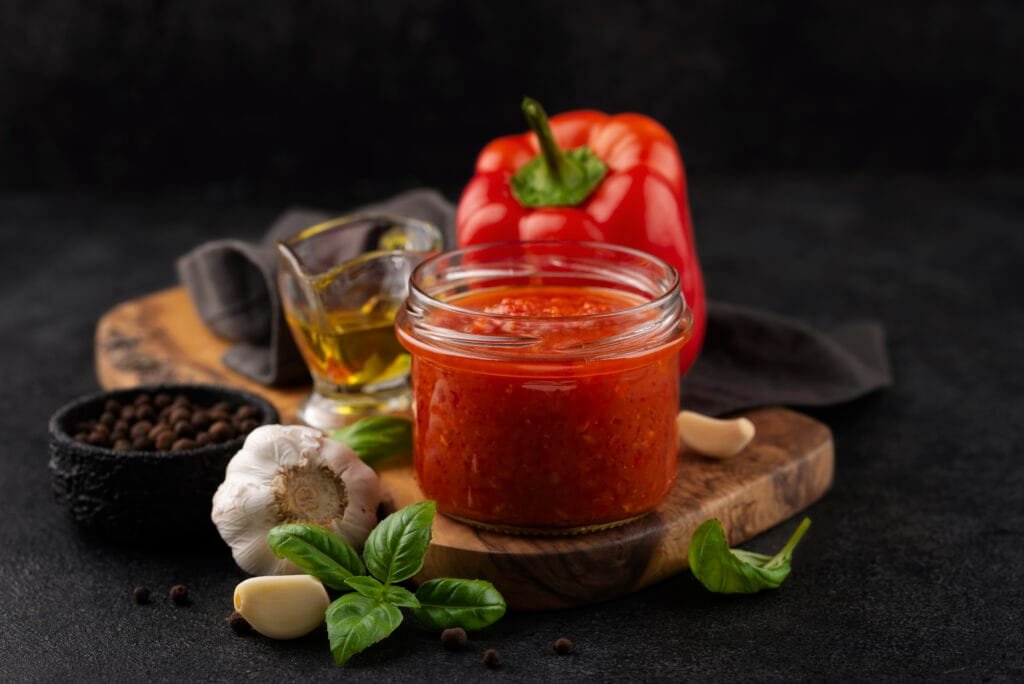
These five sauces for meal prep cover every flavor profile you’ll need for varied, exciting meals. Each recipe takes less than 10 minutes to prepare, stores for at least a week, and transforms the same base ingredients into completely different dishes. Master these meal prep sauces and you’ll never eat a boring bowl again.
1. Lemon-Herb Tahini Sauce (Mediterranean Vibes)
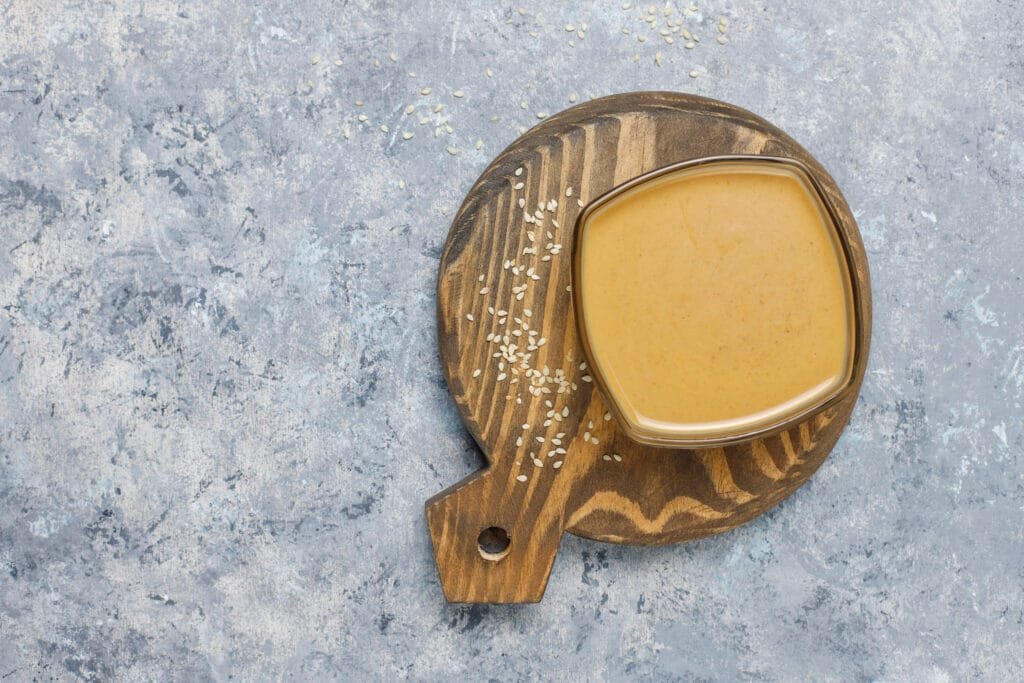
Makes about 1.5 cups | Keeps 7 days refrigerated
Ingredients:
- 1/2 cup tahini
- 1/4 cup fresh lemon juice (about 2 lemons)
- 2-3 garlic cloves
- 1/4 cup fresh parsley
- 2 tablespoons fresh dill (or 1 tablespoon dried)
- 1/2 teaspoon salt
- 1/4 teaspoon black pepper
- 4-6 tablespoons warm water (for consistency)
Instructions:
- Blend tahini, lemon juice, and garlic until smooth
- Add herbs, salt, and pepper
- Slowly add warm water until you reach a pourable but thick consistency
- Taste and adjust salt/lemon as needed
Perfect for: Roasted vegetable bowls, chickpea salads, grain bowls, as a dip for raw vegetables
Pro tip: This sauce gets thicker in the fridge. Add a tablespoon of warm water and whisk before using if needed.
2. Spicy Peanut Sauce (Asian-Inspired)
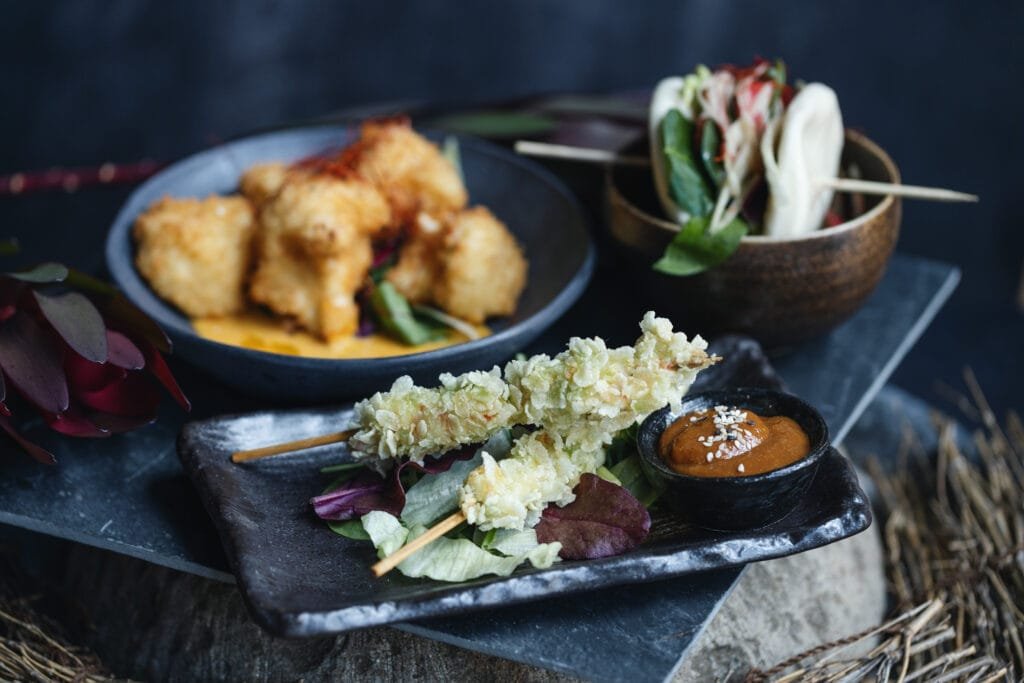
Makes about 1.25 cups | Keeps 10 days refrigerated
- 1/2 cup natural peanut butter (no sugar added)
- 3 tablespoons soy sauce (or tamari for gluten-free)
- 2 tablespoons rice vinegar
- 1 tablespoon sesame oil
- 1 tablespoon honey or maple syrup
- 2 teaspoons fresh grated ginger
- 2-3 garlic cloves
- 1-2 teaspoons chili garlic sauce (adjust to taste)
- 4-6 tablespoons warm water
Instructions:
- Whisk peanut butter until smooth
- Add soy sauce, vinegar, sesame oil, and sweetener
- Blend in ginger, garlic, and chili sauce
- Thin with warm water to desired consistency
- Let sit 30 minutes for flavors to develop
Perfect for: Asian noodle bowls, steamed vegetable plates, spring rolls, tofu marinades
Storage note: This sauce can separate slightly. Just whisk before using.
3. Creamy Avocado-Lime Dressing (Mexican-Style)
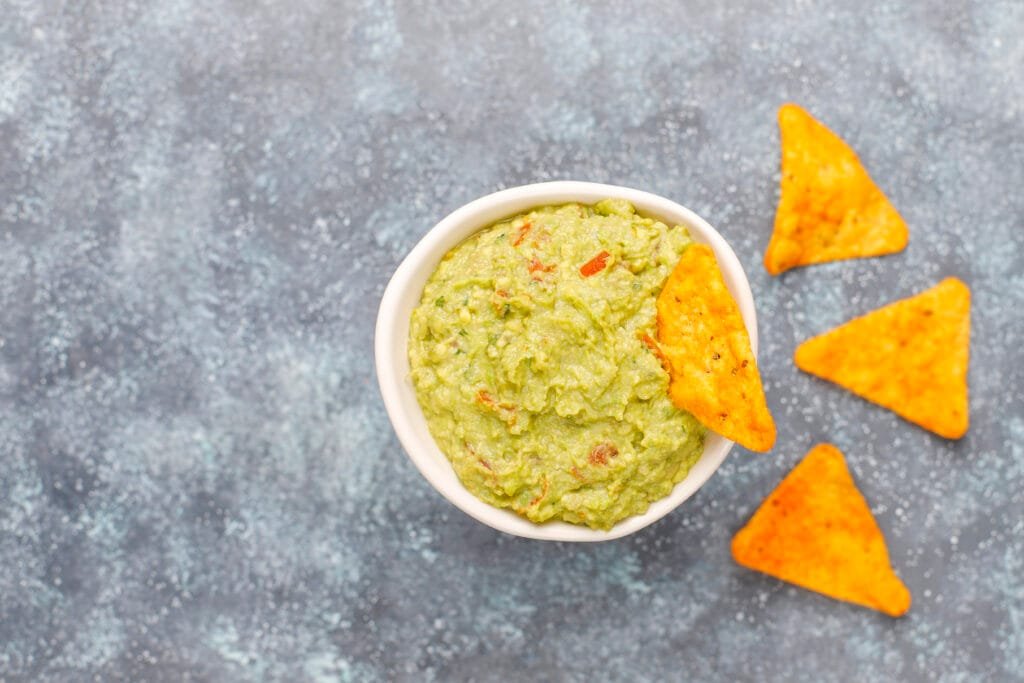
Makes about 1.5 cups | Best sed within 3-4 days
Ingredients:
- 2 ripe avocados
- 1/4 cup fresh lime juice (about 2 limes)
- 1/4 cup cilantro leaves
- 2 garlic cloves
- 1 jalapeño, seeded (optional for heat)
- 1/2 teaspoon ground cumin
- 1/2 teaspoon salt
- 3-4 tablespoons water (as needed)
Instructions:
- Halve and pit avocados
- Blend all ingredients except water until smooth
- Add water gradually until you reach desired consistency
- Taste and adjust lime/salt balance
Perfect for: Black bean bowls, Mexican-inspired salads, as a dip for vegetables, drizzled over tacos
Freshness tip: Press plastic wrap directly onto the surface before refrigerating to prevent browning.
4. Balsamic-Herb Vinaigrette (Italian-Inspired)
Makes about 1 cup | Keeps 2 weeks refrigerated
Ingredients:
- 1/3 cup good quality balsamic vinegar
- 2/3 cup extra virgin olive oil
- 2 tablespoons Dijon mustard
- 2 garlic cloves, minced
- 2 tablespoons fresh basil, chopped (or 1 tablespoon dried)
- 1 tablespoon fresh oregano (or 1 teaspoon dried)
- 1 teaspoon salt
- 1/2 teaspoon black pepper
- 1 teaspoon honey (optional, for balance)
Instructions:
- Whisk balsamic vinegar with mustard and garlic
- Slowly drizzle in olive oil while whisking constantly
- Add herbs, salt, pepper, and honey
- Let stand 15 minutes, then taste and adjust
Perfect for: Italian-style grain bowls, caprese salads, roasted vegetable medleys, pasta salad.
Emulsification tip: This dressing separates naturally. Shake or whisk vigorously before each use.
5. Green Goddess Dressing (Fresh & Herby)
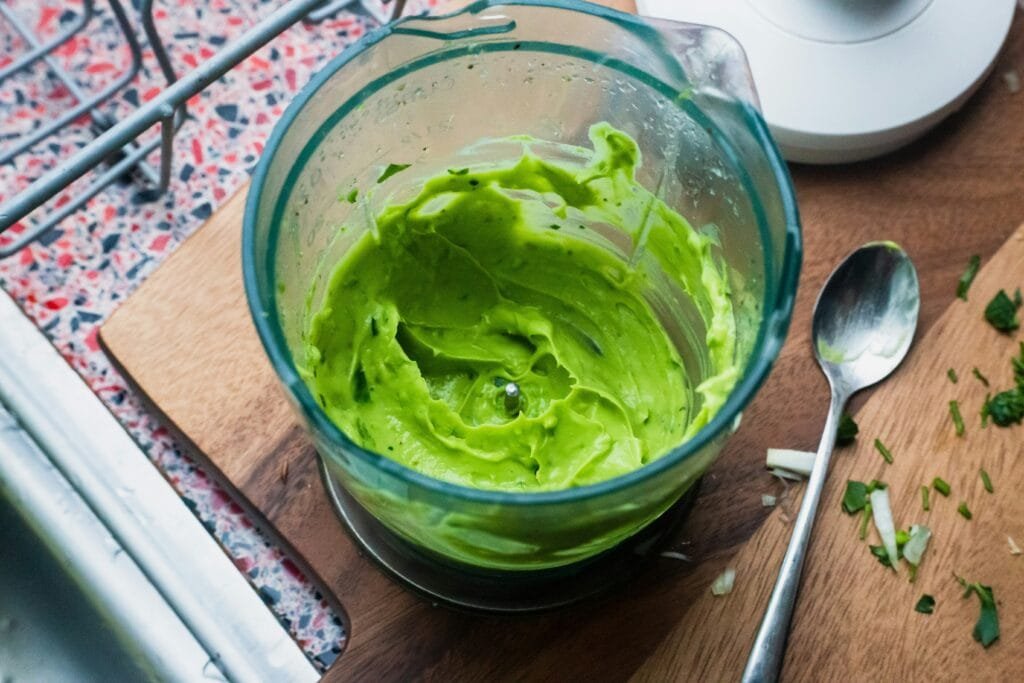
Makes about 1.5 cups | Keeps 5-6 days refrigerated
Ingredients:
- 1/2 cup Greek yogurt (plain, full-fat works best)
- 1/4 cup mayonnaise (or vegan mayo)
- 1/4 cup fresh parsley
- 2 tablespoons fresh chives
- 2 tablespoons fresh dill
- 1 green onion, chopped
- 2 garlic cloves
- 2 tablespoons fresh lemon juice
- 1/2 teaspoon salt
- 1/4 teaspoon black pepper
- 2-3 tablespoons water (if needed for consistency)
Instructions:
- Blend yogurt and mayo until smooth
- Add all herbs, green onion, and garlic
- Blend until bright green and smooth
- Add lemon juice, salt, and pepper
- Thin with water if desired
Perfect for: Grain bowls, salads, as a dip for raw vegetables, dolloped on soups
Herb tip: This dressing is only as good as your herbs are fresh. Avoid if herbs are wilted or browning.
Sauce Storage & Organization System for Meal Prep
Storage Containers
I use 8 oz mason jarsfor each sauce, which provides the perfect amount for one week of meals. The wide mouth makes it easy to whisk thickened sauces.
Labeling System
Each jar gets a piece of masking tape with:
- Sauce name
- Date made
- “Best by” date (I’m conservative with timing)
Fridge Organization
I keep all meal prep sauces on the same shelf for easy access. Having them at eye level means I actually remember to use them.
Batch Making Strategy
I make 2-3 sauces each Sunday, rotating through the collection so I always have variety without overwhelming my prep time.
Weekly Meal Prep Sauce Rotation Strategy
Week 1: Mediterranean Theme
- Lemon-Herb Tahini
- Balsamic-Herb Vinaigrette
- Green Goddess (for variety)
Week 2: Global Fusion
- Spicy Peanut Sauce
- Avocado-Lime Dressing
- Lemon-Herb Tahini (it’s that good)
Week 3: Fresh & Light
- Green Goddess
- Avocado-Lime
- Balsamic-Herb Vinaigrette
This rotation prevents sauce fatigue while ensuring I always have complementary flavors available.
Transforming Basic Meal Prep Components

Here’s how the same base ingredients become completely different meals with these sauces:
Base Bowl: Quinoa + Roasted Broccoli + Chickpeas
Monday (Mediterranean): + Lemon-Herb Tahini + cucumber + cherry tomatoes + olives Tuesday (Asian): + Spicy Peanut Sauce + shredded carrots + edamame + sesame seeds Wednesday (Mexican): + Avocado-Lime Dressing + black beans instead of chickpeas + corn + peppers Thursday (Italian): + Balsamic-Herb Vinaigrette + sun-dried tomatoes + fresh mozzarella + basil Friday (Fresh): + Green Goddess + mixed greens + cucumber + radishes
Same prep work, five completely different flavor experiences.
Cost Analysis: Homemade vs. Store-Bought
Lemon-Herb Tahini Sauce
Homemade cost: ~$3.50 (makes 1.5 cups) Store-bought equivalent: $6-8 for comparable quality Savings: 40-55% per batch
Spicy Peanut Sauce
Homemade cost: ~$2.25 (makes 1.25 cups) Store-bought equivalent: $4-6 Savings: 45-60% per batch
Annual savings making these sauces:** Approximately $150-200. Plus, these sauces for meal prep give you complete control over ingredients and nutrition.
The time investment (about 45 minutes weekly) pays for itself in both money saved and meals enjoyed.
Troubleshooting Common Sauce Issues
Even experienced cooks encounter these issues when making meal prep sauces. Here’s how to fix them:
Sauce Too Thick
Solution: Add liquid (water, citrus juice, or oil) one tablespoon at a time until desired consistency is reached.
Sauce Too Thin
Solution: Add more of the base ingredient (tahini, peanut butter, avocado, etc.) or let it sit in the fridge to thicken naturally.
Flavors Seem Flat
Solution: Usually needs more acid (lemon, lime, vinegar) or salt. Add a small amount, taste, and adjust.
Sauce Separated
Solution: This is normal for oil-based dressings. Whisk vigorously or shake in a sealed jar before using.
Garlic Too Strong
Solution: Add a bit of sweetener (honey, maple syrup) to balance the intensity.
Meal Prep Integration Tips
Sunday Routine
I make these meal prep sauces first during my Sunday prep session while other ingredients roast or cook. This maximizes efficiency and lets flavors develop while I work on other tasks.
Portion Control
I portion 2-3 tablespoons of each sauce into small containers along with my meal prep bowls. This prevents over-using expensive homemade sauces.
Recipe Scaling
All these recipes can be halved if you’re prepping for fewer meals, or doubled if you want to freeze portions for later use.
New to meal prep? Check out our complete beginner’s guide to healthy vegetarian meal prep for step-by-step instructions on planning your first week.
Beyond Meal Prep: Other Creative Uses for These Sauces
While these are designed as sauces for meal prep, they’re versatile enough for everyday cooking too.
Lemon-Herb Tahini
- Salad dressing for dinner parties
- Dip for fresh vegetables during TV watching
- Spread for sandwiches and wraps
Spicy Peanut Sauce
- Dipping sauce for spring rolls or dumplings
- Marinade for tofu before grilling
- Drizzle for Asian-inspired pizza
Avocado-Lime Dressing
- Dip for tortilla chips
- Spread for quesadillas
- Dressing for taco salads
Balsamic-Herb Vinaigrette
- Marinade for grilled vegetables
- Bread dipping oil
- Light sauce for pasta dishes
Green Goddess
- Dip for crudité platters
- Spread for sandwiches
- Sauce for baked potatoes
Seasonal Sauce Adaptations

One of the best things about homemade meal prep sauces is how easily they adapt to seasonal ingredients.
Spring Variations
- Add fresh pea shoots or microgreens to Green Goddess
- Incorporate fresh mint into the Avocado-Lime dressing
- Use spring onions instead of regular garlic in any sauce
Summer Modifications
- Blend fresh corn kernels into Avocado-Lime for sweetness and texture
- Add fresh tomato juice to thin the Balsamic vinaigrette
- Include fresh basil from your garden in any sauce
Fall Adjustments
- Add a touch of maple syrup to Peanut Sauce for seasonal warmth
- Incorporate roasted garlic instead of raw for deeper flavors
- Blend in butternut squash puree to Tahini sauce for creaminess
Winter Comfort
- Add warming spices like cumin or paprika to any sauce
- Use roasted red peppers in place of fresh herbs when they’re expensive
- Incorporate miso paste into Peanut sauce for umami depth
Sauce Pairing Guide for Different Proteins
Tofu & Tempeh
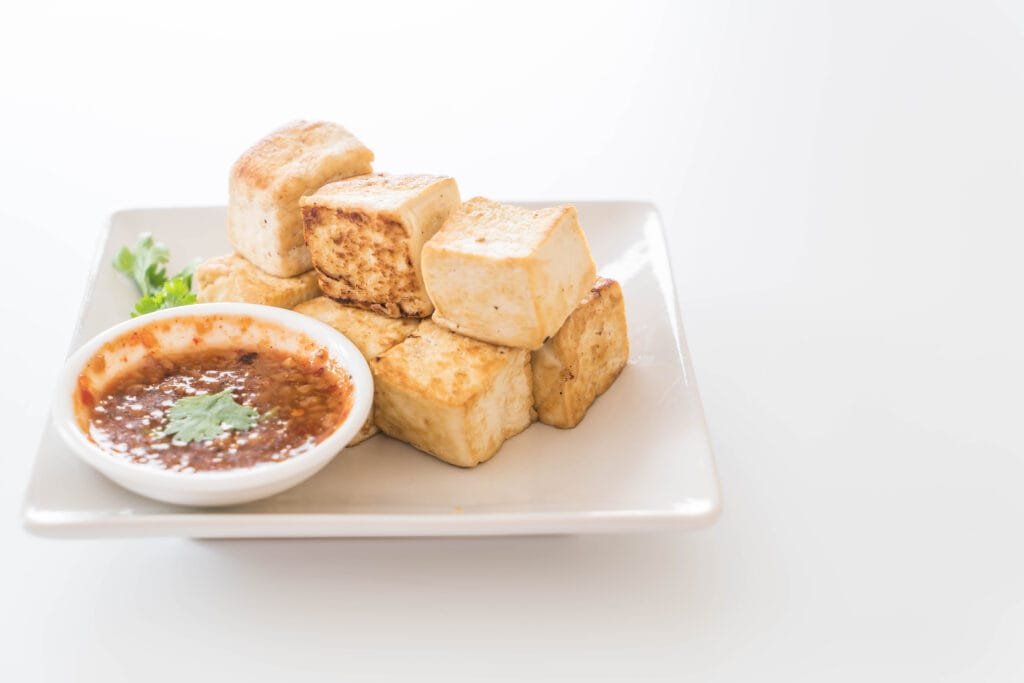
Best matches: Spicy Peanut Sauce, Lemon-Herb Tahini Why: These proteins absorb flavors well and benefit from bold, complex sauces
Beans & Lentils
Best matches: Balsamic-Herb Vinaigrette, Avocado-Lime Dressing Why: The acidity cuts through the earthiness and adds brightness
Eggs
Best matches: Green Goddess, Avocado-Lime Dressing Why: Creamy sauces complement eggs’ rich texture without overwhelming
Cheese-Based Dishes
Best matches: Balsamic-Herb Vinaigrette, Lemon-Herb Tahini Why: Acid-based sauces balance rich, creamy cheese
Advanced Sauce Techniques
Layering Flavors
Don’t just use one sauce per bowl. Try:
- A thin layer of Tahini sauce on the bottom
- Your grain and protein components
- A drizzle of Balsamic vinaigrette on top
Temperature Contrast
- Warm grain bowls with cold Avocado-Lime dressing
- Room temperature salads with slightly warmed Peanut sauce
- Cold cucumber salads with herb-forward Green Goddess
Texture Combinations
- Smooth Tahini sauce + crunchy seeds
- Creamy Avocado dressing + crispy roasted chickpeas
- Chunky Peanut sauce + soft steamed vegetables
Scaling for Special Occasions
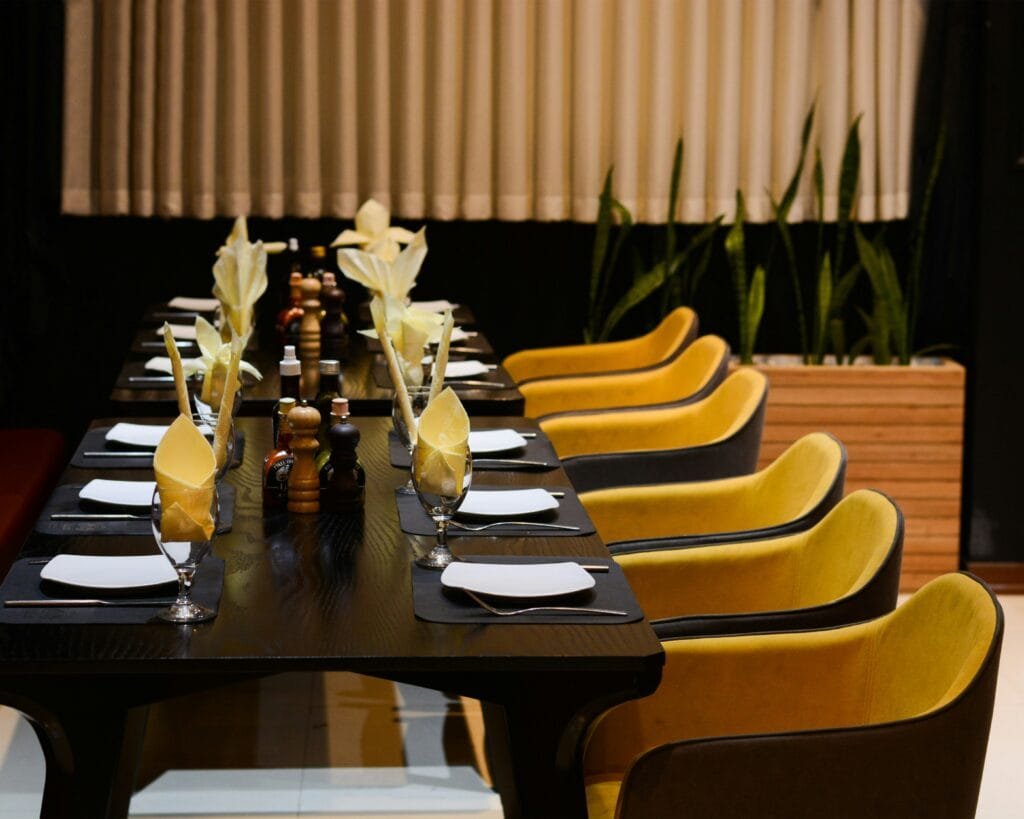
Dinner Party Quantities (Serves 8-10)
- Triple each recipe
- Make 2-3 complementary sauces instead of 5
- Provide small spoons for guests to try different combinations
Meal Prep for Two Weeks
- Double all recipes
- Freeze half portions in ice cube trays, then transfer to freezer bags
- Label clearly with contents and date
Single Person Portions
- Halve each recipe
- Focus on 2-3 sauces maximum to prevent waste
- Use smaller storage containers
Quality Ingredients Make a Difference
Tahini Selection
Choose tahini that’s just ground sesame seeds—no added oils or sugars. The Premium Tahini brand I use has a much creamier texture than budget versions.
- MADE IN THE USA – Our products are proudly made in California, using only the finest premium sesame seeds.
- ORGANIC AND NON-GMO – Our products are all-natural, organic, and non-GMO.
- 100% PREMIUM QUALITY – NO additives, NO chemicals, NO preservatives, NO salt are added to our product leaving it 100% Natural and Kosher Certified.
Oil Quality Matters
For the Balsamic vinaigrette, good olive oil is essential. I splurge onHigh Quality Olive Oil for dressings but use regular olive oil for cooking.
- EXPERIENCE THE TASTE OF CALIFORNIA QUALITY: Our award- winning Cold Pressed 100% California Extra Virgin Olive Oil is crafted from our farms and…
- MOST AWARDED: The Most Awarded US Olive Oil Company in 2025 by the 2025 World Olive Oil Rankings.
- ALWAYS CERTIFIED: The cold-pressed Extra Virgin Olive Oil from all our brands is rigorously tested by both our expert team and external certifying…
Fresh vs. Dried Herbs
Fresh herbs create brighter, more complex flavors, but dried herbs work in a pinch. If using dried, use 1/3 the amount called for with fresh.
Citrus Tips
Always use freshly squeezed citrus juice—bottled versions lack the bright flavor that makes these sauces special. A Citrus Juicer makes this task much easier.
- NON-STOP JUICING: Powers through tough ingredients for powerful, non-stop juicing.
- CONTROL PULP: Total Pulp Control allows for customized juice with two interchangeable pulp filters: Less Pulp and Lots of Pulp.
- PROGRAMS: 2 one-touch programs for simple use: Start/Stop and Reverse.
Nutrition Benefits of Homemade Sauces
Healthy Fats
- Tahini provides selenium and healthy monounsaturated fats
- Avocados offer potassium and heart-healthy oleic acid
- Olive oil contains antioxidants and anti-inflammatory compounds
Reduced Sodium
Homemade sauces typically contain 40-60% less sodium than commercial versions, giving you better control over your daily intake.
According to the USDA’s Dietary Guidelines, reducing sodium intake is important for heart health, and homemade dressings give you complete control over salt levels.
No Added Sugars
Most store-bought dressings contain high fructose corn syrup or other added sugars. These recipes use minimal natural sweeteners only when needed for balance.
Probiotic Benefits
The Greek yogurt in Green Goddess provides beneficial probiotics for digestive health.
Meal Prep Success Stories
Sarah’s Transformation
“I used to spend $15-20 weekly on different salad dressings and still got bored with my lunches. Making these five sauces for meal prep costs me about $8 total and completely transformed my meal prep game. My coworkers are always asking what smells so good when I heat up my lunch!”
Mike’s Budget Win
“As a grad student, every dollar counts. Learning to make these sauces has saved me roughly $30 monthly on condiments and dressings. Plus, my meal prep bowls actually taste restaurant-quality now.”
Lisa’s Health Journey
“I was shocked to discover how much sodium and sugar were in my favorite store-bought dressings. Making my own has helped me reduce inflammation and feel more energetic. The Avocado-Lime dressing has become my family’s obsession!”
Building Your Sauce-Making Confidence
Start with One
Don’t feel pressured to make all five sauces for meal prep immediately. Pick the one that sounds most appealing and master it first.
Taste as You Go
These recipes are guidelines. Your tomatoes might be more acidic, your tahini might be thicker. Trust your palate and adjust accordingly.
Keep Notes
I keep a small notebook in my kitchen where I jot down modifications that work. “Added extra lime to avocado sauce—perfect!” helps me remember for next time.
Don’t Fear Failure
My first attempt at Peanut sauce was so thick it was basically peanut butter with soy sauce. Every sauce-making disaster has taught me something valuable about ratios and techniques. Once you master one of these meal prep sauces, the others will feel easy.
Seasonal Shopping for Sauce Ingredients

Spring Shopping List
- Fresh herbs start becoming affordable
- Citrus is still in peak season
- Early avocados from California
Summer Abundance
- Herbs are at their peak and cheapest
- Perfect time to make extra sauces and freeze portions
- Farmers market herbs often cost less than grocery stores
Fall Preparation
- Stock up on shelf-stable ingredients (tahini, oils, vinegars)
- Buy and freeze fresh herbs before prices rise
- Good time to experiment with roasted vegetable variations
Winter Strategies
- Focus on sauces using dried herbs and pantry ingredients
- Greenhouse herbs, while more expensive, still cost less than premium dressings
- Perfect time for heartier, warming sauce variations
The Environmental Impact
Making your own sauces reduces packaging waste significantly:
- Five homemade sauces = zero plastic bottles in landfills
- Buying ingredients in bulk reduces per-unit packaging
- Glass storage jars are reusable indefinitely
- Reduced transportation emissions from not shipping water-heavy commercial dressings
Final Thoughts: Your Sauce-Making Journey
The transformation these five sauces have made in my meal prep routine still amazes me months later. What started as a solution to bland, repetitive meals has become one of my sauces for meal prep in Sunday kitchen activities. There’s something deeply satisfying about opening my fridge to see those neat rows of colorful, homemade sauces, knowing each one represents dozens of delicious meals ahead.
The investment in good ingredients pays dividends in both flavor and nutrition. The time spent blending and tasting feels meditative after a busy week. And the money saved—nearly $200 annually—feels like a small victory every time I skip the salad dressing aisle at the grocery store.
Most importantly, these sauces have eliminated the “what should I eat?” decision fatigue that used to plague my weekday lunches. Now I simply grab whatever combination sounds appealing, knowing the flavors will be restaurant-quality and perfectly suited to my tastes.
Pair these sauces with our 25 easy vegetarian meal prep ideas for a complete system that keeps meals exciting all week long.
Start with one sauce this Sunday. I recommend the Lemon-Herb Tahini—it’s forgiving, versatile, and absolutely transformative drizzled over any combination of vegetables and grains. Once you experience the difference homemade sauce makes, you’ll understand why this has become such an essential part of my vegetarian meal prep routine.
Your taste buds (and your budget) will thank you.
Ready to transform your meal prep with flavor? Download my free “Sauce Pairing Cheat Sheet” that shows exactly which sauces work best with different vegetarian protein and vegetable combinations.
Questions about any of these sauces? Drop a comment below—I love helping fellow meal preppers create more flavorful, exciting meals!

